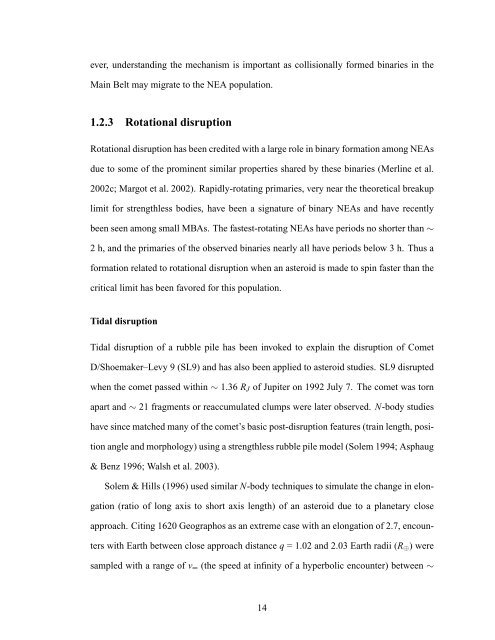Forming Binary Near-Earth Asteroids From Tidal Disruptions
Forming Binary Near-Earth Asteroids From Tidal Disruptions
Forming Binary Near-Earth Asteroids From Tidal Disruptions
Create successful ePaper yourself
Turn your PDF publications into a flip-book with our unique Google optimized e-Paper software.
ever, understanding the mechanism is important as collisionally formed binaries in theMain Belt may migrate to the NEA population.1.2.3 Rotational disruptionRotational disruption has been credited with a large role in binary formation among NEAsdue to some of the prominent similar properties shared by these binaries (Merline et al.2002c; Margot et al. 2002). Rapidly-rotating primaries, very near the theoretical breakuplimit for strengthless bodies, have been a signature of binary NEAs and have recentlybeen seen among small MBAs. The fastest-rotating NEAs have periods no shorter than ∼2 h, and the primaries of the observed binaries nearly all have periods below 3 h. Thus aformation related to rotational disruption when an asteroid is made to spin faster than thecritical limit has been favored for this population.<strong>Tidal</strong> disruption<strong>Tidal</strong> disruption of a rubble pile has been invoked to explain the disruption of CometD/Shoemaker–Levy 9 (SL9) and has also been applied to asteroid studies. SL9 disruptedwhen the comet passed within ∼ 1.36 R J of Jupiter on 1992 July 7. The comet was tornapart and ∼ 21 fragments or reaccumulated clumps were later observed. N-body studieshave since matched many of the comet’s basic post-disruption features (train length, positionangle and morphology) using a strengthless rubble pile model (Solem 1994; Asphaug& Benz 1996; Walsh et al. 2003).Solem & Hills (1996) used similar N-body techniques to simulate the change in elongation(ratio of long axis to short axis length) of an asteroid due to a planetary closeapproach. Citing 1620 Geographos as an extreme case with an elongation of 2.7, encounterswith <strong>Earth</strong> between close approach distance q = 1.02 and 2.03 <strong>Earth</strong> radii (R ⊕ ) weresampled with a range of v ∞ (the speed at infinity of a hyperbolic encounter) between ∼14












